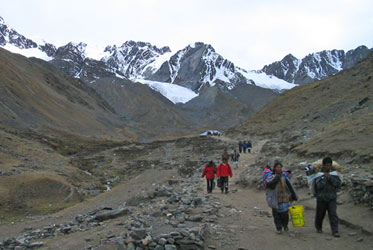Pilgrims on the trail to the Lord of Qoyllorit’i shrine. Photo by Robin Van Loon
Ch’unchus in the Highlands
Every year in the high Andes of Peru, tens of thousands of pilgrims walk a cold stony trail to the base of one of the region’s many glaciers. Some go barefoot, while others crawl on hands and knees in penance to a miraculous apparition housed in an isolated chapel.
The destination of the pilgrims’ sojourn sits at 4,200 meters (14,000 feet) above sea level. The Lord of Qoyllorit’i is an image of Christ that appeared on a boulder that was previously the site of reverent pre-Columbian rituals of a mountain-honoring nature. The Qoyllorit’i shrine’s feast day attracts devotees who seek cures for the incurable, blessings for marriages and baptisms, and auspicious signs of good fortune in the coming year.
But many of the pilgrims simply come to dance.
Donning elaborate outfits and masks, adorned with parrot feathers, colorful cloth and talismans of various kinds, the dance troops at Qoyllorit’i form an unbroken lineage with those who have paid homage to this shrine for hundreds of years or more. Their ritual dances are rooted in myth.
Andean legend passed down as oral history describes how an ancient race of giants was wiped out with the coming of the Inkas, an event described symbolically as the ‘first ever dawning of the sun’. Before that there was a pre-Inka race of giants called ñawpa runa (ancient people) or machukuna (old ones), names that inspired reverence and fear. We are told the old ones were worshipped by the humans of those distant times but were considered moody and dangerous, fierce and sometimes unjust rulers who nonetheless possessed god-like spiritual power.
The arrival of the Inkas (who claimed to trace their bloodline to the sun itself) ostensibly marked the beginning of human – and humane – rule. At the time of the first dawning of the sun, many of the old giants realized their reign was over and fled to hiding places where the light could not reach them. Others capriciously stood their ground and were turned to stone on the spot by the sun’s rays – hence the Andean identification of strangely shaped boulders with local divinities called huacas.
The hiding places chosen by the giants that fled from the sun were in themselves sites of reverence – the highest glaciers and mountaintops, still called apu (lord) to this day in many parts of Quechua-speaking Peru; and the lowland forests far below the final flanks of the Andes to the east, shrouded in mystery and seen by some pre-hispanic Andeans as a repository of magic. Those legendary giants who successfully slipped into the jungle were called ch’unchus, a name still frequently used by present day Andeans in reference to Amazonian people.
The Dance of the Ch’unchos
Legend has it that one particular giant, a powerful but fair lord, was making his escape to the peak of Sinak’ara, belonging to the Qolqepunku glacier in whose shadow now sits the chapel of the Lord of Qoyllorit’i. Out of loyalty to their master, the giant’s human subjects followed him en masse to beg him to stay among them. Knowing that he would be turned to stone, the giant agreed to stay if the people would make him one promise: that each year they come dressed as ch’unchus to dance before him. One tradition holds that the annual festivities at Qoyllorit’i do not begin until the ch’unchus from the nearby town of Paucartambo dance the first dance.
In the high Andean town of Ocongate, a dance troop of Qhapaq Ch’uncho prepares to board their truck to the Qoyllorit’i trail head further up the road.
The image is a tender one: the giant’s request was that the people join him in celebration, assuming the appearance of his peers who had escaped to the forests below. Each year, the people come to fulfill that pact. They come in groups called comparsas, dance troops, often representing a specific group or traditional guild. Troops of high tundra-dwelling llama herders line up to dance behind troops dressed in satire as corrupt urban officials swilling alcohol. Some costumes include long white sleeves in representation of wallatas, the gull-like birds of the highland lagoons.
With feather headdresses and long pijuayo staffs, the Wayri Ch’uncho dancers are an Andean representation of Amazonians. Photograph and original caption by Guillermo Salas Careño.
Other dancers are the religious event’s equivalent of police, dressed in a guise that has been interpreted as Andean spectacled bears or perhaps young alpacas, there to enforce the ceremony’s rules and to carry out the sacred task of marching up into the glacial ice fields. Many elements of the Andean cosmovision are included: colorful devils or saqra move in hypnotic synchronization as troops of women in tall hats perform a dance meant among other things to demonstrate marriageability. There are even dancers who dress in a kind of black face as Africans. The sad, slow song of the Qhapaq Negros is a sympathetic homage to the Spaniard’s imported slaves who in some sense shared the same fate as the conquest-era Andeans.
But the most vital dance troops of all are the ch’unchus, whose role it is to begin the celebration. At Qoyllorit’i, dance is an offering made to a divinity, once a stone-encased giant and now a mysterious image of Christ appearing upon the same boulder. There is joy but also great solemnity in the dancing, and in no dance is this more evident than in that of the ch’unchus. Bamboo flutes blow out a simple repeating melody and rawhide drums tap a festive Amazonian rhythm while dancers move in graceful loping skips.
There are several kinds of ch’unchu dancers – the wayri ch’unchus, the q’ara ch’unchos (warriors), and the qhapaq ch’unchus (representing nobility). The wayri ch’unchus are the favorites of the petrified giant and are the first to dance. They are dressed in representation of Amazonian natives and have parrot feathers rising from their heads. The qhapaq ch’unchus look comparatively regal in colorful, silky garb and with long brilliant macaw tail feathers standing straight up from their heads as a sign of nobility.
Each dancer carries in his hand a long, sturdy staff. As the dancers weave between each other in looping patterns they hit each other’s staffs with a resounding crack. In keeping with tradition, the staffs are made of chonta, a kind of wood from the jungle. If asked, many dancers are unaware that this same chonta was used frequently by their Inka ancestors. Little do they know that year after year they dance with the wood of a tree that could in a sense be called the ‘Apple of the Amazon’: pijuayo, or Bactris gasipaes, known in English as the peach palm.




